Marketing Issues in Food Industry: Research Proposal Analysis
VerifiedAdded on 2023/06/09
|27
|6601
|196
Project
AI Summary
This research proposal delves into the marketing challenges encountered by the food industry, particularly within the US market. It begins by outlining the problem statement, which highlights the difficulties faced by convenience stores and food retailers in attracting customers due to evolving consumer preferences and the need for effective marketing strategies. The research poses the central question: what challenges does the food industry face when making marketing decisions? This is further explored through subset questions, such as the key aspects to consider in marketing strategy, the composition of marketing teams, the impact of marketing strategies on profitability, and how leadership can ensure relevance to the consumer base. The rationale underscores the need for effective marketing to maintain and increase market demand, and the proposal defines key terms like "marketing strategy" and "product distribution channels." The literature review examines marketing strategy, aspects of an effective marketing strategy (including market segmentation, competitor analysis, and brand positioning), and challenges like content quality. The methodology section will outline the research philosophy, approach, purpose, data collection, analysis, sampling techniques, ethical considerations, limitations, and timeframe, culminating in expected outcomes. The proposal aims to provide a comprehensive analysis of the current marketing landscape in the food industry and offer insights to overcome the challenges faced by businesses.
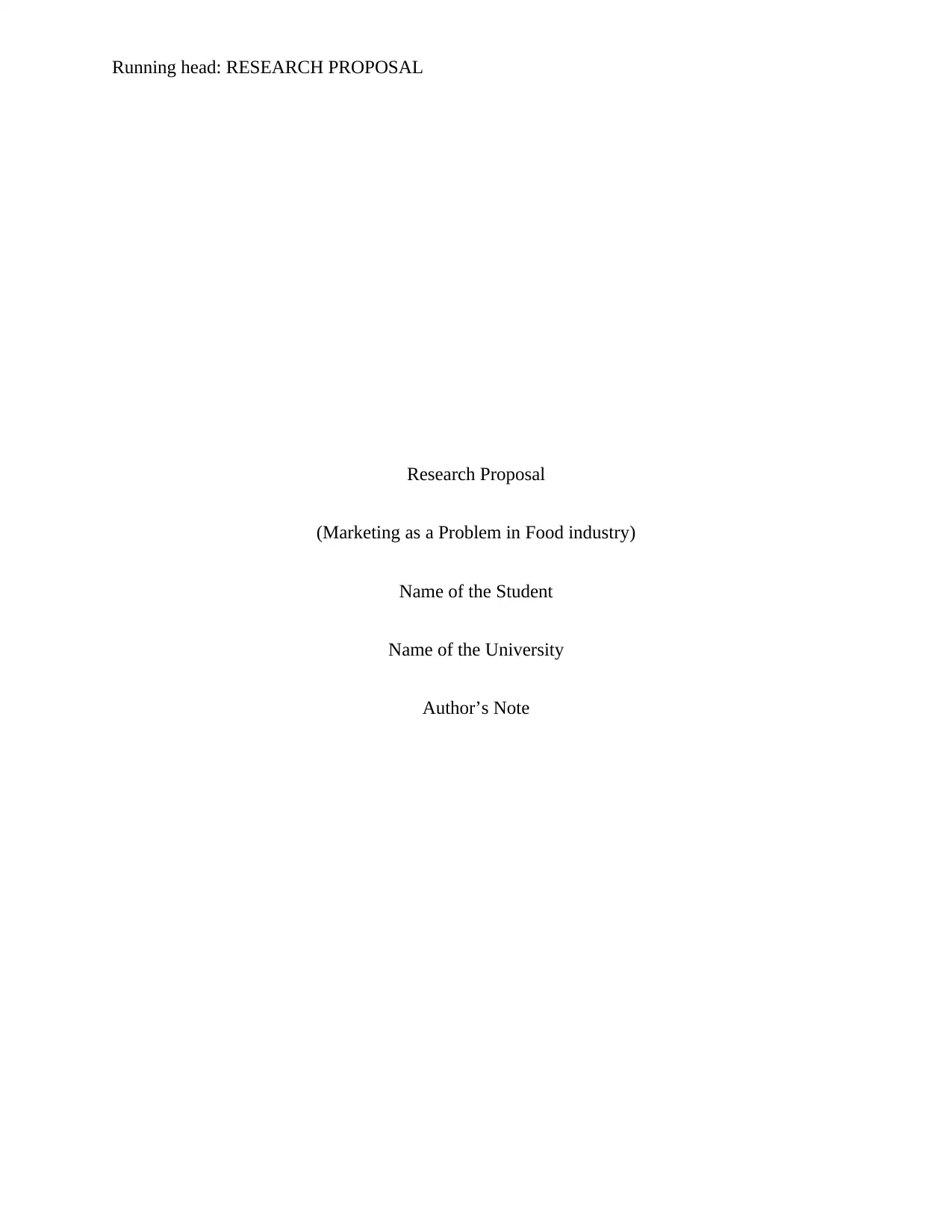
Running head: RESEARCH PROPOSAL
Research Proposal
(Marketing as a Problem in Food industry)
Name of the Student
Name of the University
Author’s Note
Research Proposal
(Marketing as a Problem in Food industry)
Name of the Student
Name of the University
Author’s Note
Paraphrase This Document
Need a fresh take? Get an instant paraphrase of this document with our AI Paraphraser
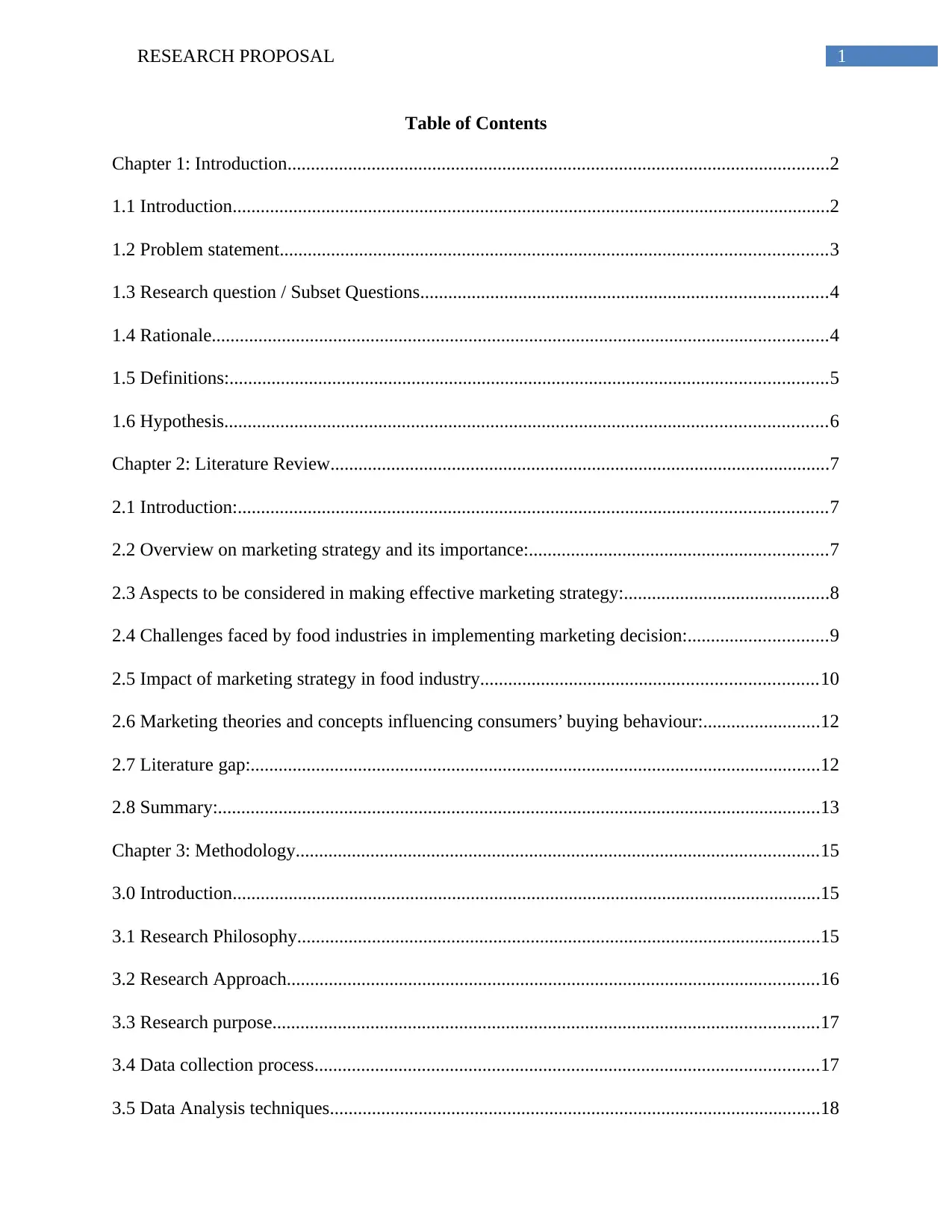
1RESEARCH PROPOSAL
Table of Contents
Chapter 1: Introduction....................................................................................................................2
1.1 Introduction................................................................................................................................2
1.2 Problem statement.....................................................................................................................3
1.3 Research question / Subset Questions.......................................................................................4
1.4 Rationale....................................................................................................................................4
1.5 Definitions:................................................................................................................................5
1.6 Hypothesis.................................................................................................................................6
Chapter 2: Literature Review...........................................................................................................7
2.1 Introduction:..............................................................................................................................7
2.2 Overview on marketing strategy and its importance:................................................................7
2.3 Aspects to be considered in making effective marketing strategy:............................................8
2.4 Challenges faced by food industries in implementing marketing decision:..............................9
2.5 Impact of marketing strategy in food industry........................................................................10
2.6 Marketing theories and concepts influencing consumers’ buying behaviour:.........................12
2.7 Literature gap:..........................................................................................................................12
2.8 Summary:.................................................................................................................................13
Chapter 3: Methodology................................................................................................................15
3.0 Introduction..............................................................................................................................15
3.1 Research Philosophy................................................................................................................15
3.2 Research Approach..................................................................................................................16
3.3 Research purpose.....................................................................................................................17
3.4 Data collection process............................................................................................................17
3.5 Data Analysis techniques.........................................................................................................18
Table of Contents
Chapter 1: Introduction....................................................................................................................2
1.1 Introduction................................................................................................................................2
1.2 Problem statement.....................................................................................................................3
1.3 Research question / Subset Questions.......................................................................................4
1.4 Rationale....................................................................................................................................4
1.5 Definitions:................................................................................................................................5
1.6 Hypothesis.................................................................................................................................6
Chapter 2: Literature Review...........................................................................................................7
2.1 Introduction:..............................................................................................................................7
2.2 Overview on marketing strategy and its importance:................................................................7
2.3 Aspects to be considered in making effective marketing strategy:............................................8
2.4 Challenges faced by food industries in implementing marketing decision:..............................9
2.5 Impact of marketing strategy in food industry........................................................................10
2.6 Marketing theories and concepts influencing consumers’ buying behaviour:.........................12
2.7 Literature gap:..........................................................................................................................12
2.8 Summary:.................................................................................................................................13
Chapter 3: Methodology................................................................................................................15
3.0 Introduction..............................................................................................................................15
3.1 Research Philosophy................................................................................................................15
3.2 Research Approach..................................................................................................................16
3.3 Research purpose.....................................................................................................................17
3.4 Data collection process............................................................................................................17
3.5 Data Analysis techniques.........................................................................................................18
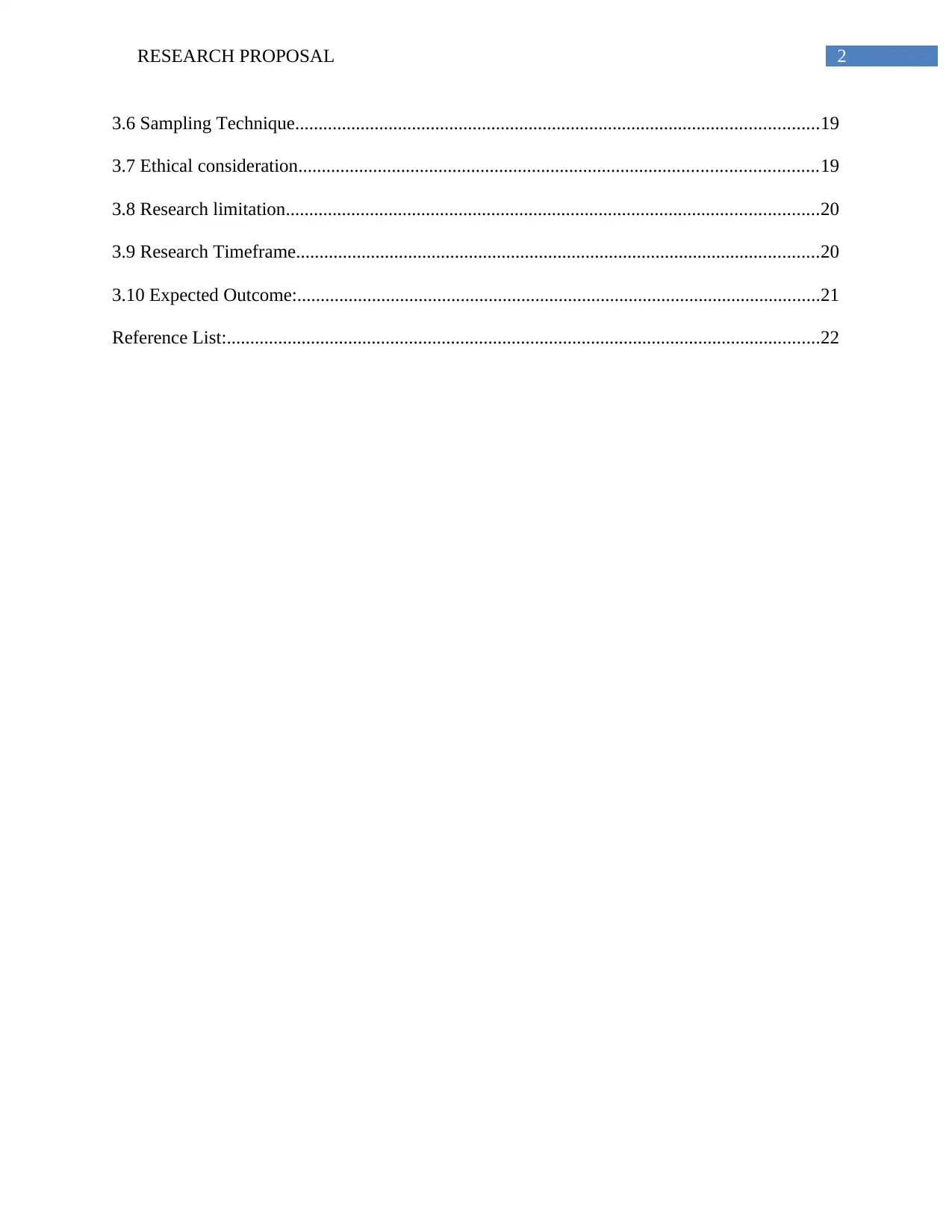
2RESEARCH PROPOSAL
3.6 Sampling Technique................................................................................................................19
3.7 Ethical consideration...............................................................................................................19
3.8 Research limitation..................................................................................................................20
3.9 Research Timeframe................................................................................................................20
3.10 Expected Outcome:................................................................................................................21
Reference List:...............................................................................................................................22
3.6 Sampling Technique................................................................................................................19
3.7 Ethical consideration...............................................................................................................19
3.8 Research limitation..................................................................................................................20
3.9 Research Timeframe................................................................................................................20
3.10 Expected Outcome:................................................................................................................21
Reference List:...............................................................................................................................22
⊘ This is a preview!⊘
Do you want full access?
Subscribe today to unlock all pages.

Trusted by 1+ million students worldwide
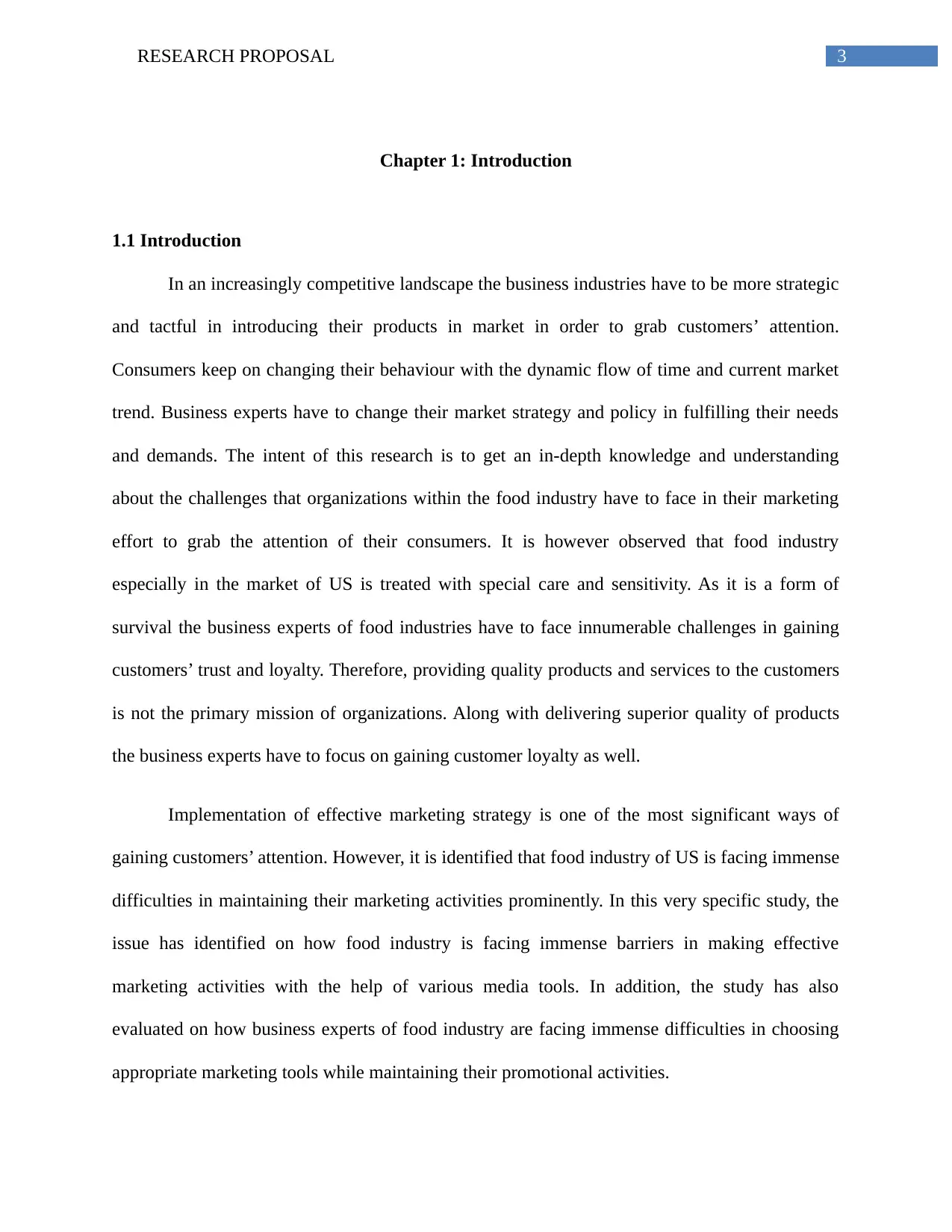
3RESEARCH PROPOSAL
Chapter 1: Introduction
1.1 Introduction
In an increasingly competitive landscape the business industries have to be more strategic
and tactful in introducing their products in market in order to grab customers’ attention.
Consumers keep on changing their behaviour with the dynamic flow of time and current market
trend. Business experts have to change their market strategy and policy in fulfilling their needs
and demands. The intent of this research is to get an in-depth knowledge and understanding
about the challenges that organizations within the food industry have to face in their marketing
effort to grab the attention of their consumers. It is however observed that food industry
especially in the market of US is treated with special care and sensitivity. As it is a form of
survival the business experts of food industries have to face innumerable challenges in gaining
customers’ trust and loyalty. Therefore, providing quality products and services to the customers
is not the primary mission of organizations. Along with delivering superior quality of products
the business experts have to focus on gaining customer loyalty as well.
Implementation of effective marketing strategy is one of the most significant ways of
gaining customers’ attention. However, it is identified that food industry of US is facing immense
difficulties in maintaining their marketing activities prominently. In this very specific study, the
issue has identified on how food industry is facing immense barriers in making effective
marketing activities with the help of various media tools. In addition, the study has also
evaluated on how business experts of food industry are facing immense difficulties in choosing
appropriate marketing tools while maintaining their promotional activities.
Chapter 1: Introduction
1.1 Introduction
In an increasingly competitive landscape the business industries have to be more strategic
and tactful in introducing their products in market in order to grab customers’ attention.
Consumers keep on changing their behaviour with the dynamic flow of time and current market
trend. Business experts have to change their market strategy and policy in fulfilling their needs
and demands. The intent of this research is to get an in-depth knowledge and understanding
about the challenges that organizations within the food industry have to face in their marketing
effort to grab the attention of their consumers. It is however observed that food industry
especially in the market of US is treated with special care and sensitivity. As it is a form of
survival the business experts of food industries have to face innumerable challenges in gaining
customers’ trust and loyalty. Therefore, providing quality products and services to the customers
is not the primary mission of organizations. Along with delivering superior quality of products
the business experts have to focus on gaining customer loyalty as well.
Implementation of effective marketing strategy is one of the most significant ways of
gaining customers’ attention. However, it is identified that food industry of US is facing immense
difficulties in maintaining their marketing activities prominently. In this very specific study, the
issue has identified on how food industry is facing immense barriers in making effective
marketing activities with the help of various media tools. In addition, the study has also
evaluated on how business experts of food industry are facing immense difficulties in choosing
appropriate marketing tools while maintaining their promotional activities.
Paraphrase This Document
Need a fresh take? Get an instant paraphrase of this document with our AI Paraphraser
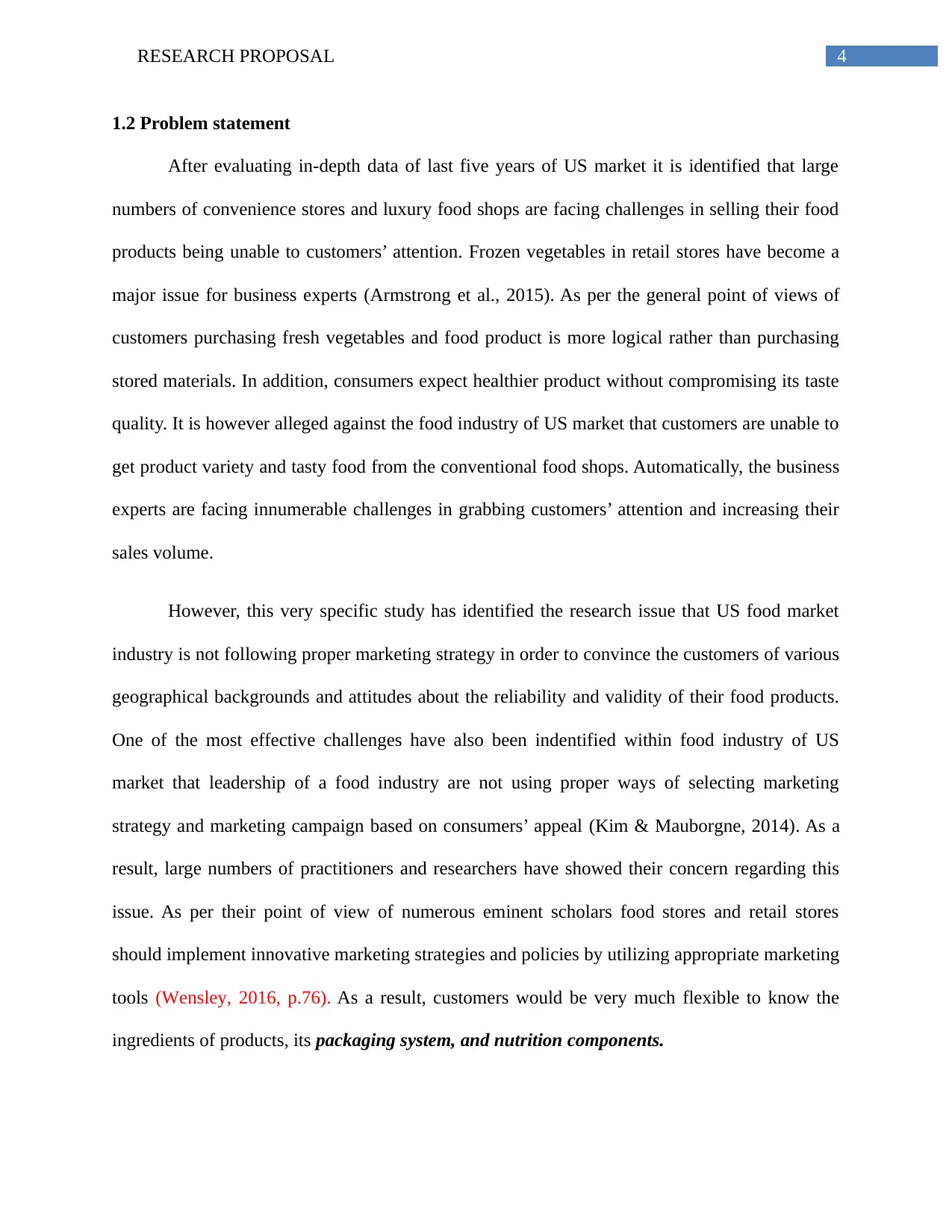
4RESEARCH PROPOSAL
1.2 Problem statement
After evaluating in-depth data of last five years of US market it is identified that large
numbers of convenience stores and luxury food shops are facing challenges in selling their food
products being unable to customers’ attention. Frozen vegetables in retail stores have become a
major issue for business experts (Armstrong et al., 2015). As per the general point of views of
customers purchasing fresh vegetables and food product is more logical rather than purchasing
stored materials. In addition, consumers expect healthier product without compromising its taste
quality. It is however alleged against the food industry of US market that customers are unable to
get product variety and tasty food from the conventional food shops. Automatically, the business
experts are facing innumerable challenges in grabbing customers’ attention and increasing their
sales volume.
However, this very specific study has identified the research issue that US food market
industry is not following proper marketing strategy in order to convince the customers of various
geographical backgrounds and attitudes about the reliability and validity of their food products.
One of the most effective challenges have also been indentified within food industry of US
market that leadership of a food industry are not using proper ways of selecting marketing
strategy and marketing campaign based on consumers’ appeal (Kim & Mauborgne, 2014). As a
result, large numbers of practitioners and researchers have showed their concern regarding this
issue. As per their point of view of numerous eminent scholars food stores and retail stores
should implement innovative marketing strategies and policies by utilizing appropriate marketing
tools (Wensley, 2016, p.76). As a result, customers would be very much flexible to know the
ingredients of products, its packaging system, and nutrition components.
1.2 Problem statement
After evaluating in-depth data of last five years of US market it is identified that large
numbers of convenience stores and luxury food shops are facing challenges in selling their food
products being unable to customers’ attention. Frozen vegetables in retail stores have become a
major issue for business experts (Armstrong et al., 2015). As per the general point of views of
customers purchasing fresh vegetables and food product is more logical rather than purchasing
stored materials. In addition, consumers expect healthier product without compromising its taste
quality. It is however alleged against the food industry of US market that customers are unable to
get product variety and tasty food from the conventional food shops. Automatically, the business
experts are facing innumerable challenges in grabbing customers’ attention and increasing their
sales volume.
However, this very specific study has identified the research issue that US food market
industry is not following proper marketing strategy in order to convince the customers of various
geographical backgrounds and attitudes about the reliability and validity of their food products.
One of the most effective challenges have also been indentified within food industry of US
market that leadership of a food industry are not using proper ways of selecting marketing
strategy and marketing campaign based on consumers’ appeal (Kim & Mauborgne, 2014). As a
result, large numbers of practitioners and researchers have showed their concern regarding this
issue. As per their point of view of numerous eminent scholars food stores and retail stores
should implement innovative marketing strategies and policies by utilizing appropriate marketing
tools (Wensley, 2016, p.76). As a result, customers would be very much flexible to know the
ingredients of products, its packaging system, and nutrition components.
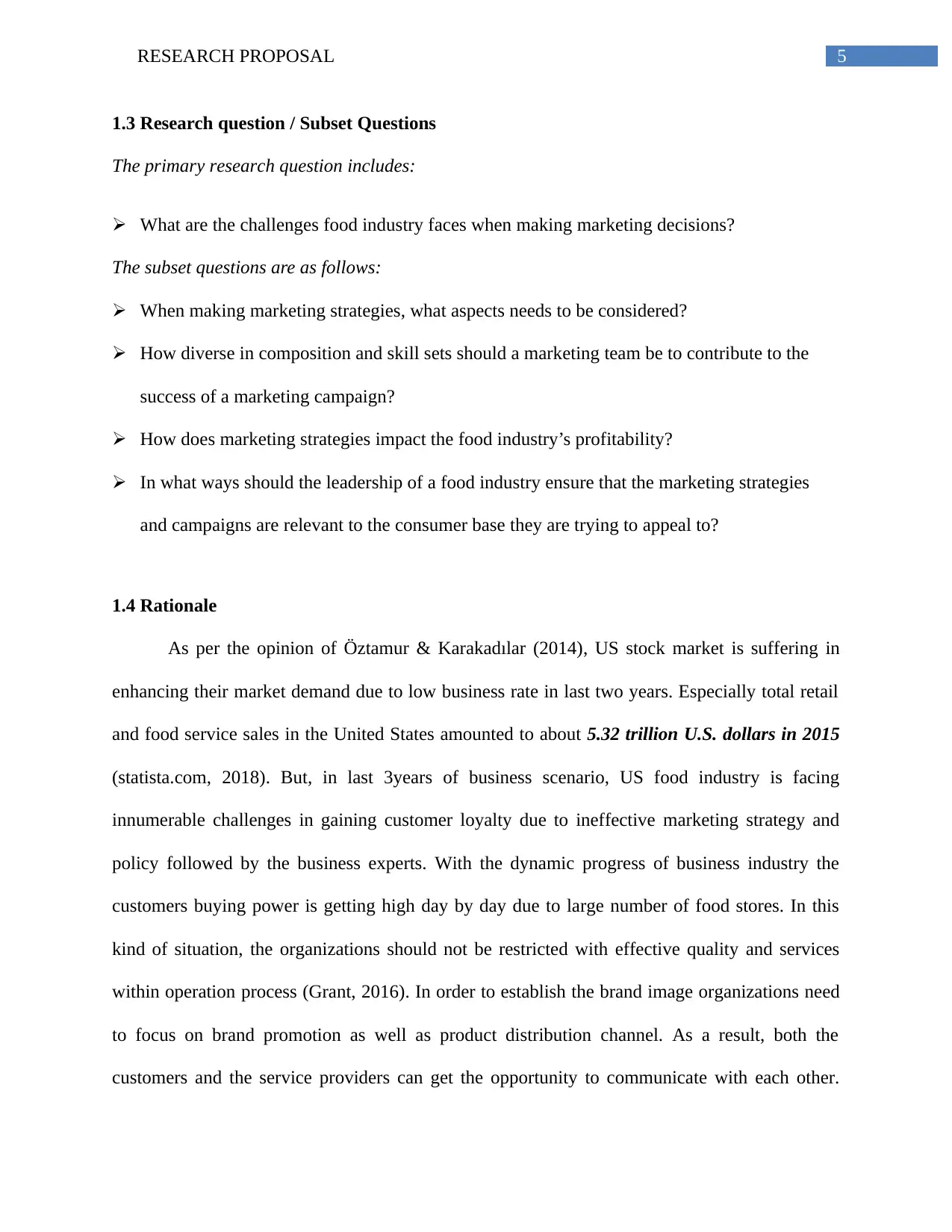
5RESEARCH PROPOSAL
1.3 Research question / Subset Questions
The primary research question includes:
What are the challenges food industry faces when making marketing decisions?
The subset questions are as follows:
When making marketing strategies, what aspects needs to be considered?
How diverse in composition and skill sets should a marketing team be to contribute to the
success of a marketing campaign?
How does marketing strategies impact the food industry’s profitability?
In what ways should the leadership of a food industry ensure that the marketing strategies
and campaigns are relevant to the consumer base they are trying to appeal to?
1.4 Rationale
As per the opinion of Öztamur & Karakadılar (2014), US stock market is suffering in
enhancing their market demand due to low business rate in last two years. Especially total retail
and food service sales in the United States amounted to about 5.32 trillion U.S. dollars in 2015
(statista.com, 2018). But, in last 3years of business scenario, US food industry is facing
innumerable challenges in gaining customer loyalty due to ineffective marketing strategy and
policy followed by the business experts. With the dynamic progress of business industry the
customers buying power is getting high day by day due to large number of food stores. In this
kind of situation, the organizations should not be restricted with effective quality and services
within operation process (Grant, 2016). In order to establish the brand image organizations need
to focus on brand promotion as well as product distribution channel. As a result, both the
customers and the service providers can get the opportunity to communicate with each other.
1.3 Research question / Subset Questions
The primary research question includes:
What are the challenges food industry faces when making marketing decisions?
The subset questions are as follows:
When making marketing strategies, what aspects needs to be considered?
How diverse in composition and skill sets should a marketing team be to contribute to the
success of a marketing campaign?
How does marketing strategies impact the food industry’s profitability?
In what ways should the leadership of a food industry ensure that the marketing strategies
and campaigns are relevant to the consumer base they are trying to appeal to?
1.4 Rationale
As per the opinion of Öztamur & Karakadılar (2014), US stock market is suffering in
enhancing their market demand due to low business rate in last two years. Especially total retail
and food service sales in the United States amounted to about 5.32 trillion U.S. dollars in 2015
(statista.com, 2018). But, in last 3years of business scenario, US food industry is facing
innumerable challenges in gaining customer loyalty due to ineffective marketing strategy and
policy followed by the business experts. With the dynamic progress of business industry the
customers buying power is getting high day by day due to large number of food stores. In this
kind of situation, the organizations should not be restricted with effective quality and services
within operation process (Grant, 2016). In order to establish the brand image organizations need
to focus on brand promotion as well as product distribution channel. As a result, both the
customers and the service providers can get the opportunity to communicate with each other.
⊘ This is a preview!⊘
Do you want full access?
Subscribe today to unlock all pages.

Trusted by 1+ million students worldwide
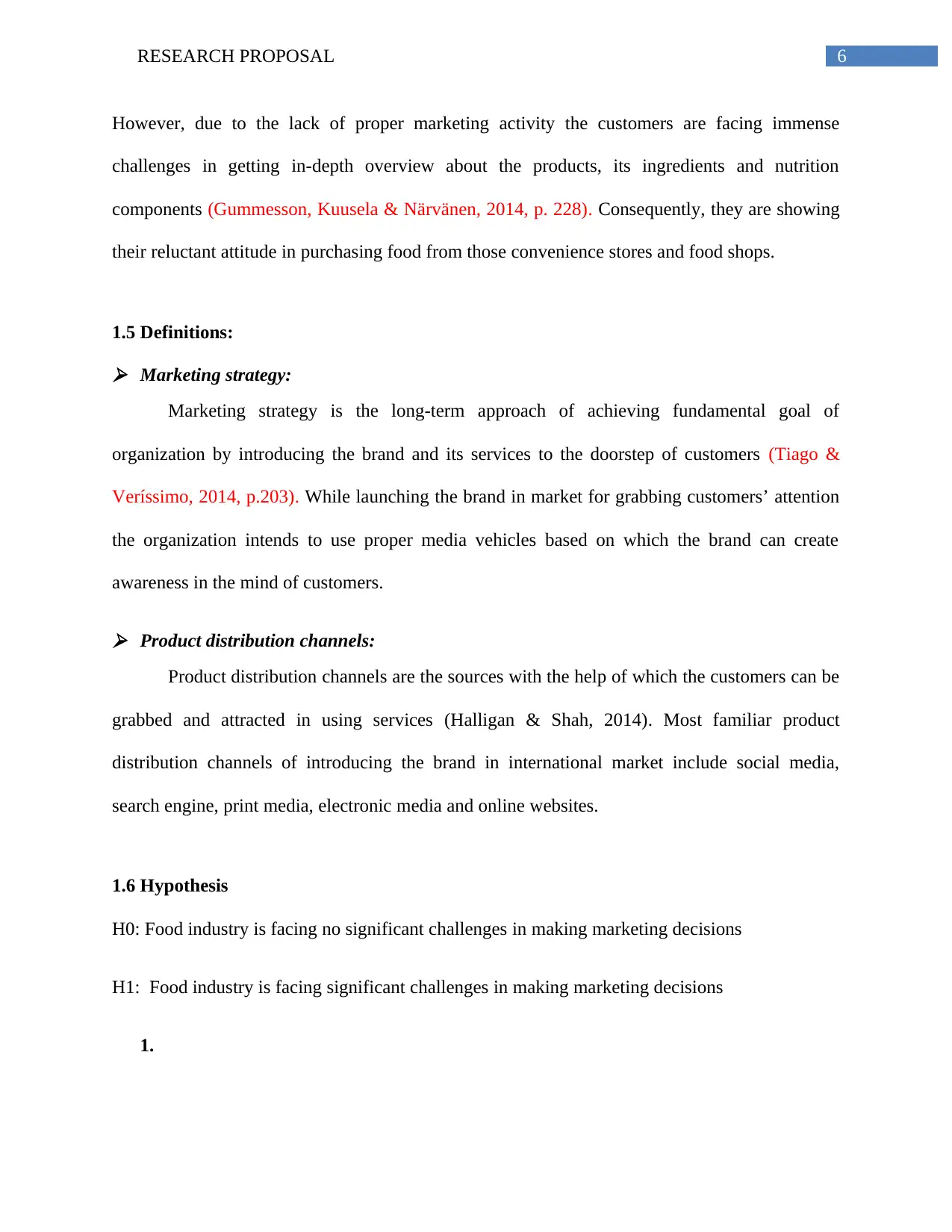
6RESEARCH PROPOSAL
However, due to the lack of proper marketing activity the customers are facing immense
challenges in getting in-depth overview about the products, its ingredients and nutrition
components (Gummesson, Kuusela & Närvänen, 2014, p. 228). Consequently, they are showing
their reluctant attitude in purchasing food from those convenience stores and food shops.
1.5 Definitions:
Marketing strategy:
Marketing strategy is the long-term approach of achieving fundamental goal of
organization by introducing the brand and its services to the doorstep of customers (Tiago &
Veríssimo, 2014, p.203). While launching the brand in market for grabbing customers’ attention
the organization intends to use proper media vehicles based on which the brand can create
awareness in the mind of customers.
Product distribution channels:
Product distribution channels are the sources with the help of which the customers can be
grabbed and attracted in using services (Halligan & Shah, 2014). Most familiar product
distribution channels of introducing the brand in international market include social media,
search engine, print media, electronic media and online websites.
1.6 Hypothesis
H0: Food industry is facing no significant challenges in making marketing decisions
H1: Food industry is facing significant challenges in making marketing decisions
1.
However, due to the lack of proper marketing activity the customers are facing immense
challenges in getting in-depth overview about the products, its ingredients and nutrition
components (Gummesson, Kuusela & Närvänen, 2014, p. 228). Consequently, they are showing
their reluctant attitude in purchasing food from those convenience stores and food shops.
1.5 Definitions:
Marketing strategy:
Marketing strategy is the long-term approach of achieving fundamental goal of
organization by introducing the brand and its services to the doorstep of customers (Tiago &
Veríssimo, 2014, p.203). While launching the brand in market for grabbing customers’ attention
the organization intends to use proper media vehicles based on which the brand can create
awareness in the mind of customers.
Product distribution channels:
Product distribution channels are the sources with the help of which the customers can be
grabbed and attracted in using services (Halligan & Shah, 2014). Most familiar product
distribution channels of introducing the brand in international market include social media,
search engine, print media, electronic media and online websites.
1.6 Hypothesis
H0: Food industry is facing no significant challenges in making marketing decisions
H1: Food industry is facing significant challenges in making marketing decisions
1.
Paraphrase This Document
Need a fresh take? Get an instant paraphrase of this document with our AI Paraphraser
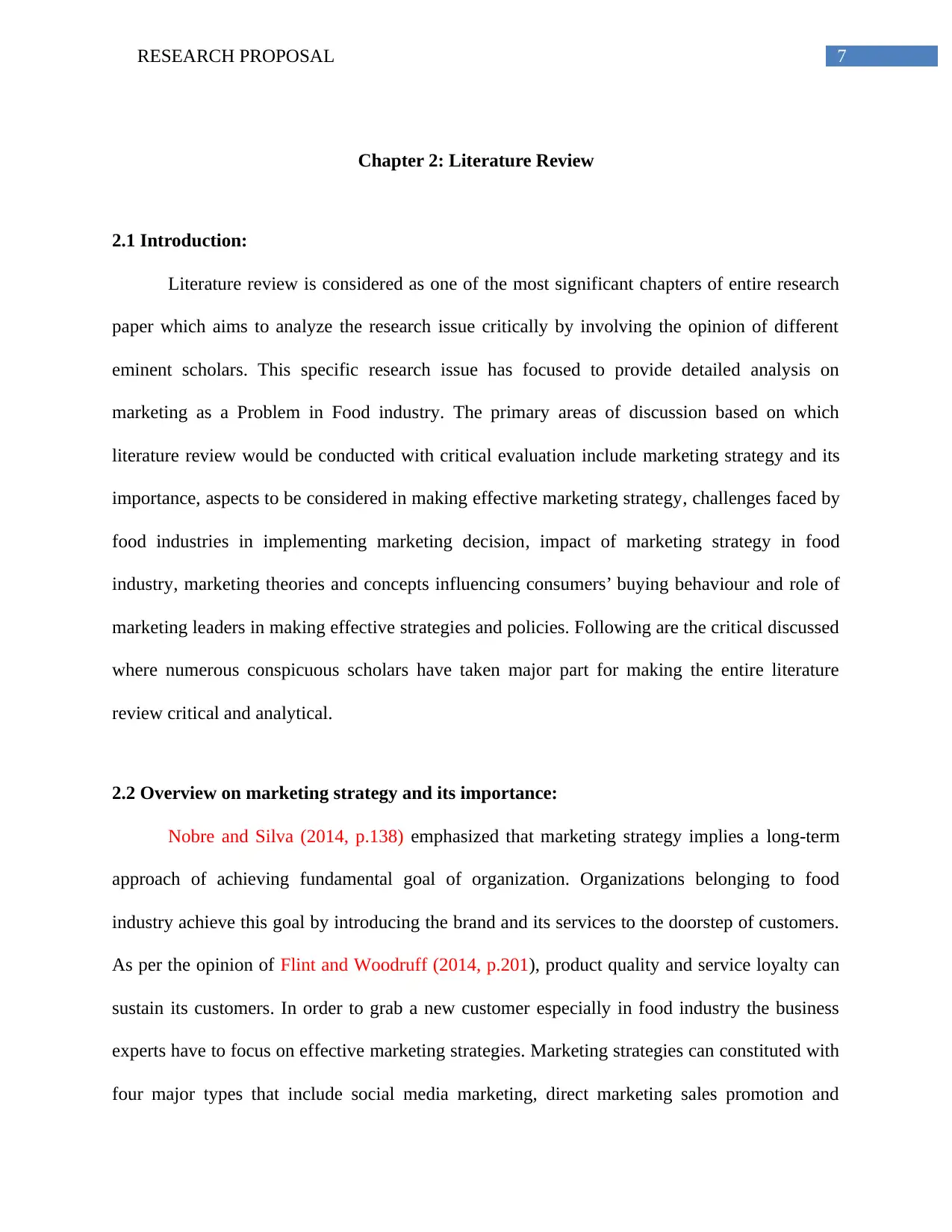
7RESEARCH PROPOSAL
Chapter 2: Literature Review
2.1 Introduction:
Literature review is considered as one of the most significant chapters of entire research
paper which aims to analyze the research issue critically by involving the opinion of different
eminent scholars. This specific research issue has focused to provide detailed analysis on
marketing as a Problem in Food industry. The primary areas of discussion based on which
literature review would be conducted with critical evaluation include marketing strategy and its
importance, aspects to be considered in making effective marketing strategy, challenges faced by
food industries in implementing marketing decision, impact of marketing strategy in food
industry, marketing theories and concepts influencing consumers’ buying behaviour and role of
marketing leaders in making effective strategies and policies. Following are the critical discussed
where numerous conspicuous scholars have taken major part for making the entire literature
review critical and analytical.
2.2 Overview on marketing strategy and its importance:
Nobre and Silva (2014, p.138) emphasized that marketing strategy implies a long-term
approach of achieving fundamental goal of organization. Organizations belonging to food
industry achieve this goal by introducing the brand and its services to the doorstep of customers.
As per the opinion of Flint and Woodruff (2014, p.201), product quality and service loyalty can
sustain its customers. In order to grab a new customer especially in food industry the business
experts have to focus on effective marketing strategies. Marketing strategies can constituted with
four major types that include social media marketing, direct marketing sales promotion and
Chapter 2: Literature Review
2.1 Introduction:
Literature review is considered as one of the most significant chapters of entire research
paper which aims to analyze the research issue critically by involving the opinion of different
eminent scholars. This specific research issue has focused to provide detailed analysis on
marketing as a Problem in Food industry. The primary areas of discussion based on which
literature review would be conducted with critical evaluation include marketing strategy and its
importance, aspects to be considered in making effective marketing strategy, challenges faced by
food industries in implementing marketing decision, impact of marketing strategy in food
industry, marketing theories and concepts influencing consumers’ buying behaviour and role of
marketing leaders in making effective strategies and policies. Following are the critical discussed
where numerous conspicuous scholars have taken major part for making the entire literature
review critical and analytical.
2.2 Overview on marketing strategy and its importance:
Nobre and Silva (2014, p.138) emphasized that marketing strategy implies a long-term
approach of achieving fundamental goal of organization. Organizations belonging to food
industry achieve this goal by introducing the brand and its services to the doorstep of customers.
As per the opinion of Flint and Woodruff (2014, p.201), product quality and service loyalty can
sustain its customers. In order to grab a new customer especially in food industry the business
experts have to focus on effective marketing strategies. Marketing strategies can constituted with
four major types that include social media marketing, direct marketing sales promotion and
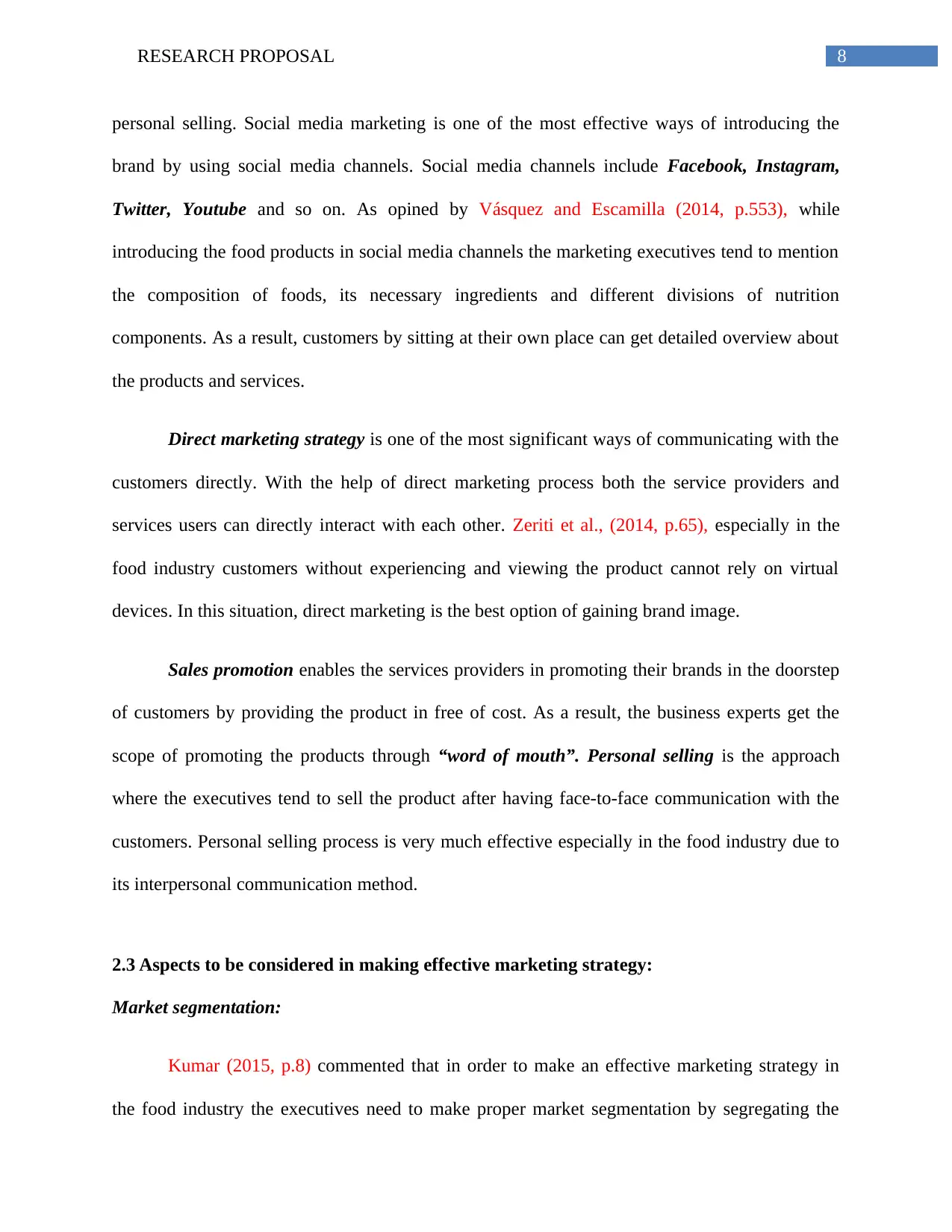
8RESEARCH PROPOSAL
personal selling. Social media marketing is one of the most effective ways of introducing the
brand by using social media channels. Social media channels include Facebook, Instagram,
Twitter, Youtube and so on. As opined by Vásquez and Escamilla (2014, p.553), while
introducing the food products in social media channels the marketing executives tend to mention
the composition of foods, its necessary ingredients and different divisions of nutrition
components. As a result, customers by sitting at their own place can get detailed overview about
the products and services.
Direct marketing strategy is one of the most significant ways of communicating with the
customers directly. With the help of direct marketing process both the service providers and
services users can directly interact with each other. Zeriti et al., (2014, p.65), especially in the
food industry customers without experiencing and viewing the product cannot rely on virtual
devices. In this situation, direct marketing is the best option of gaining brand image.
Sales promotion enables the services providers in promoting their brands in the doorstep
of customers by providing the product in free of cost. As a result, the business experts get the
scope of promoting the products through “word of mouth”. Personal selling is the approach
where the executives tend to sell the product after having face-to-face communication with the
customers. Personal selling process is very much effective especially in the food industry due to
its interpersonal communication method.
2.3 Aspects to be considered in making effective marketing strategy:
Market segmentation:
Kumar (2015, p.8) commented that in order to make an effective marketing strategy in
the food industry the executives need to make proper market segmentation by segregating the
personal selling. Social media marketing is one of the most effective ways of introducing the
brand by using social media channels. Social media channels include Facebook, Instagram,
Twitter, Youtube and so on. As opined by Vásquez and Escamilla (2014, p.553), while
introducing the food products in social media channels the marketing executives tend to mention
the composition of foods, its necessary ingredients and different divisions of nutrition
components. As a result, customers by sitting at their own place can get detailed overview about
the products and services.
Direct marketing strategy is one of the most significant ways of communicating with the
customers directly. With the help of direct marketing process both the service providers and
services users can directly interact with each other. Zeriti et al., (2014, p.65), especially in the
food industry customers without experiencing and viewing the product cannot rely on virtual
devices. In this situation, direct marketing is the best option of gaining brand image.
Sales promotion enables the services providers in promoting their brands in the doorstep
of customers by providing the product in free of cost. As a result, the business experts get the
scope of promoting the products through “word of mouth”. Personal selling is the approach
where the executives tend to sell the product after having face-to-face communication with the
customers. Personal selling process is very much effective especially in the food industry due to
its interpersonal communication method.
2.3 Aspects to be considered in making effective marketing strategy:
Market segmentation:
Kumar (2015, p.8) commented that in order to make an effective marketing strategy in
the food industry the executives need to make proper market segmentation by segregating the
⊘ This is a preview!⊘
Do you want full access?
Subscribe today to unlock all pages.

Trusted by 1+ million students worldwide
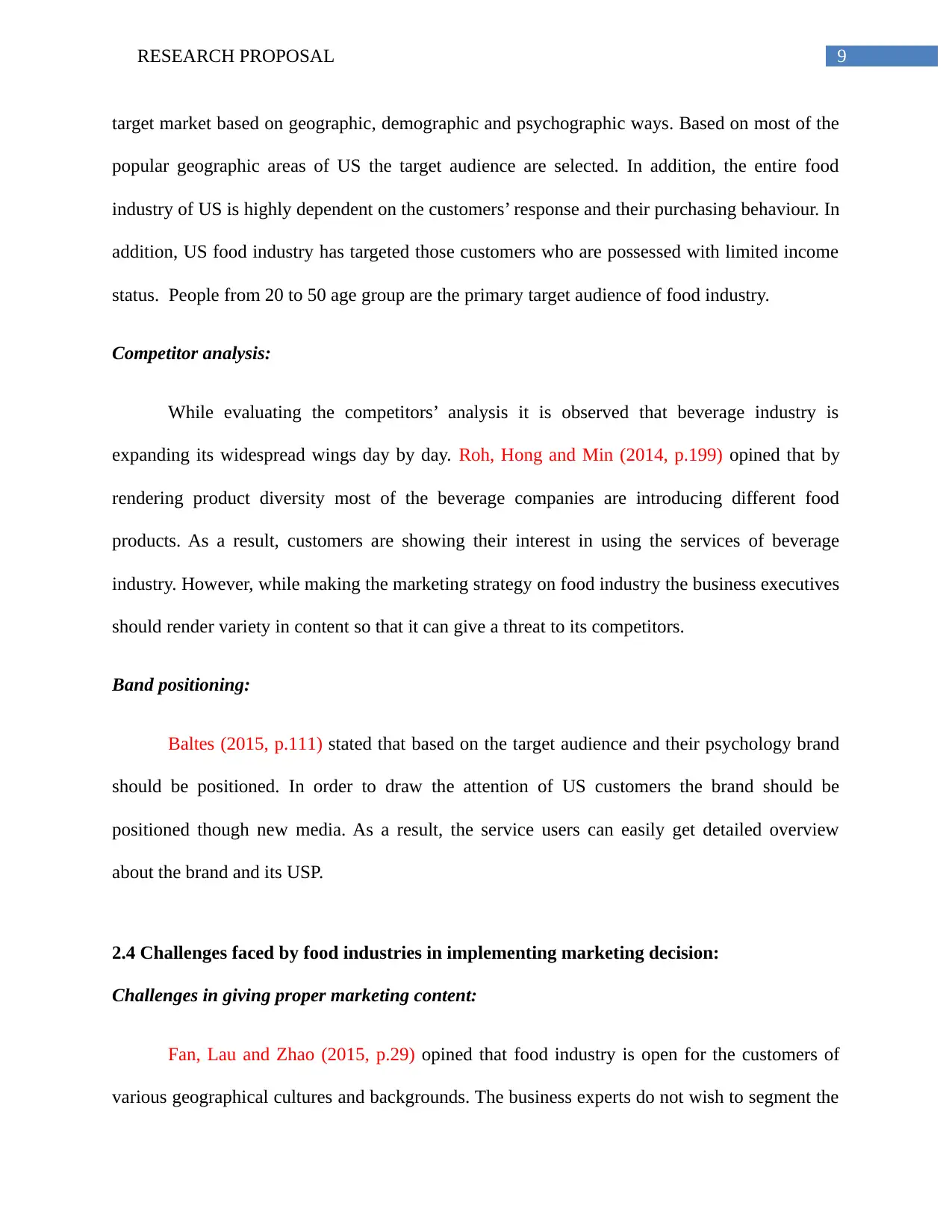
9RESEARCH PROPOSAL
target market based on geographic, demographic and psychographic ways. Based on most of the
popular geographic areas of US the target audience are selected. In addition, the entire food
industry of US is highly dependent on the customers’ response and their purchasing behaviour. In
addition, US food industry has targeted those customers who are possessed with limited income
status. People from 20 to 50 age group are the primary target audience of food industry.
Competitor analysis:
While evaluating the competitors’ analysis it is observed that beverage industry is
expanding its widespread wings day by day. Roh, Hong and Min (2014, p.199) opined that by
rendering product diversity most of the beverage companies are introducing different food
products. As a result, customers are showing their interest in using the services of beverage
industry. However, while making the marketing strategy on food industry the business executives
should render variety in content so that it can give a threat to its competitors.
Band positioning:
Baltes (2015, p.111) stated that based on the target audience and their psychology brand
should be positioned. In order to draw the attention of US customers the brand should be
positioned though new media. As a result, the service users can easily get detailed overview
about the brand and its USP.
2.4 Challenges faced by food industries in implementing marketing decision:
Challenges in giving proper marketing content:
Fan, Lau and Zhao (2015, p.29) opined that food industry is open for the customers of
various geographical cultures and backgrounds. The business experts do not wish to segment the
target market based on geographic, demographic and psychographic ways. Based on most of the
popular geographic areas of US the target audience are selected. In addition, the entire food
industry of US is highly dependent on the customers’ response and their purchasing behaviour. In
addition, US food industry has targeted those customers who are possessed with limited income
status. People from 20 to 50 age group are the primary target audience of food industry.
Competitor analysis:
While evaluating the competitors’ analysis it is observed that beverage industry is
expanding its widespread wings day by day. Roh, Hong and Min (2014, p.199) opined that by
rendering product diversity most of the beverage companies are introducing different food
products. As a result, customers are showing their interest in using the services of beverage
industry. However, while making the marketing strategy on food industry the business executives
should render variety in content so that it can give a threat to its competitors.
Band positioning:
Baltes (2015, p.111) stated that based on the target audience and their psychology brand
should be positioned. In order to draw the attention of US customers the brand should be
positioned though new media. As a result, the service users can easily get detailed overview
about the brand and its USP.
2.4 Challenges faced by food industries in implementing marketing decision:
Challenges in giving proper marketing content:
Fan, Lau and Zhao (2015, p.29) opined that food industry is open for the customers of
various geographical cultures and backgrounds. The business experts do not wish to segment the
Paraphrase This Document
Need a fresh take? Get an instant paraphrase of this document with our AI Paraphraser
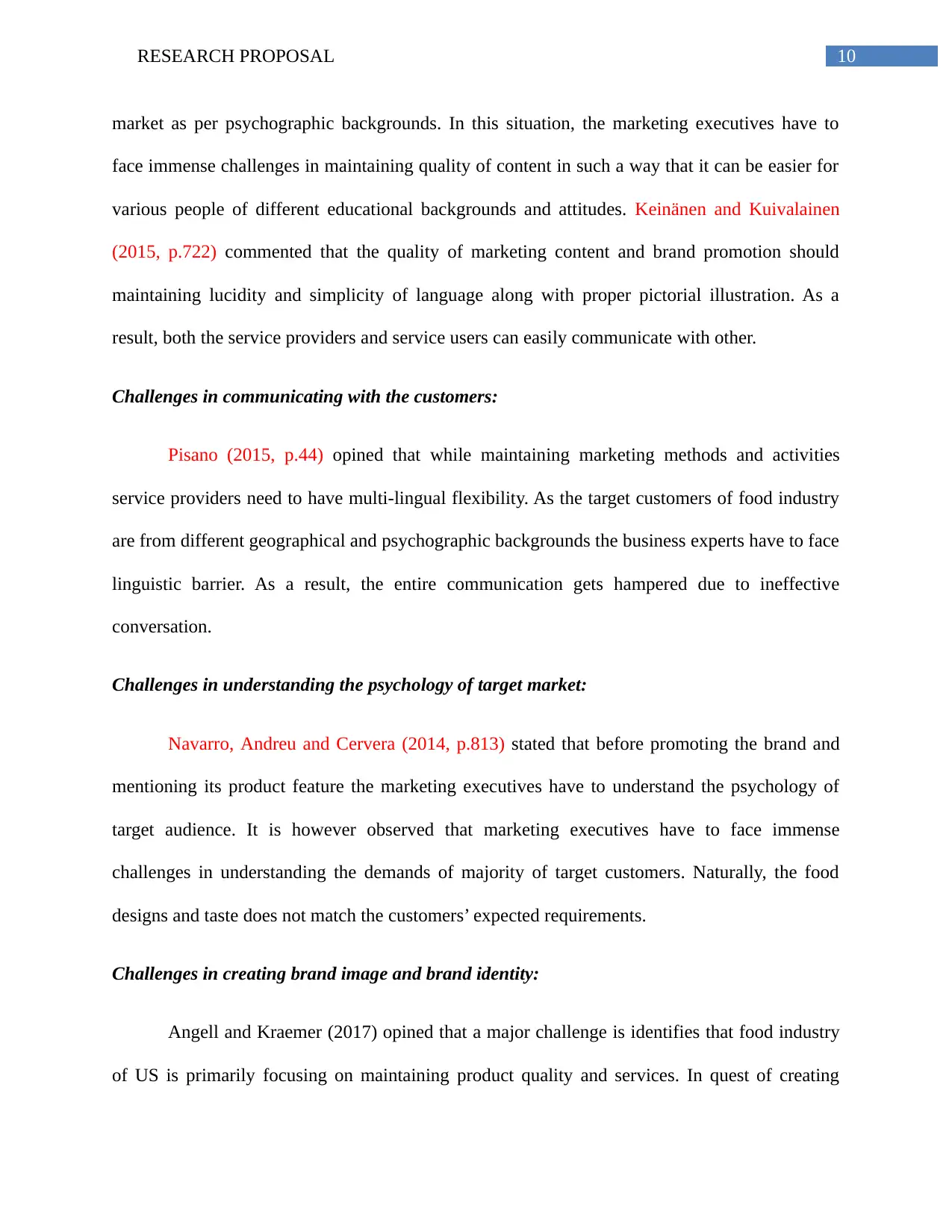
10RESEARCH PROPOSAL
market as per psychographic backgrounds. In this situation, the marketing executives have to
face immense challenges in maintaining quality of content in such a way that it can be easier for
various people of different educational backgrounds and attitudes. Keinänen and Kuivalainen
(2015, p.722) commented that the quality of marketing content and brand promotion should
maintaining lucidity and simplicity of language along with proper pictorial illustration. As a
result, both the service providers and service users can easily communicate with other.
Challenges in communicating with the customers:
Pisano (2015, p.44) opined that while maintaining marketing methods and activities
service providers need to have multi-lingual flexibility. As the target customers of food industry
are from different geographical and psychographic backgrounds the business experts have to face
linguistic barrier. As a result, the entire communication gets hampered due to ineffective
conversation.
Challenges in understanding the psychology of target market:
Navarro, Andreu and Cervera (2014, p.813) stated that before promoting the brand and
mentioning its product feature the marketing executives have to understand the psychology of
target audience. It is however observed that marketing executives have to face immense
challenges in understanding the demands of majority of target customers. Naturally, the food
designs and taste does not match the customers’ expected requirements.
Challenges in creating brand image and brand identity:
Angell and Kraemer (2017) opined that a major challenge is identifies that food industry
of US is primarily focusing on maintaining product quality and services. In quest of creating
market as per psychographic backgrounds. In this situation, the marketing executives have to
face immense challenges in maintaining quality of content in such a way that it can be easier for
various people of different educational backgrounds and attitudes. Keinänen and Kuivalainen
(2015, p.722) commented that the quality of marketing content and brand promotion should
maintaining lucidity and simplicity of language along with proper pictorial illustration. As a
result, both the service providers and service users can easily communicate with other.
Challenges in communicating with the customers:
Pisano (2015, p.44) opined that while maintaining marketing methods and activities
service providers need to have multi-lingual flexibility. As the target customers of food industry
are from different geographical and psychographic backgrounds the business experts have to face
linguistic barrier. As a result, the entire communication gets hampered due to ineffective
conversation.
Challenges in understanding the psychology of target market:
Navarro, Andreu and Cervera (2014, p.813) stated that before promoting the brand and
mentioning its product feature the marketing executives have to understand the psychology of
target audience. It is however observed that marketing executives have to face immense
challenges in understanding the demands of majority of target customers. Naturally, the food
designs and taste does not match the customers’ expected requirements.
Challenges in creating brand image and brand identity:
Angell and Kraemer (2017) opined that a major challenge is identifies that food industry
of US is primarily focusing on maintaining product quality and services. In quest of creating
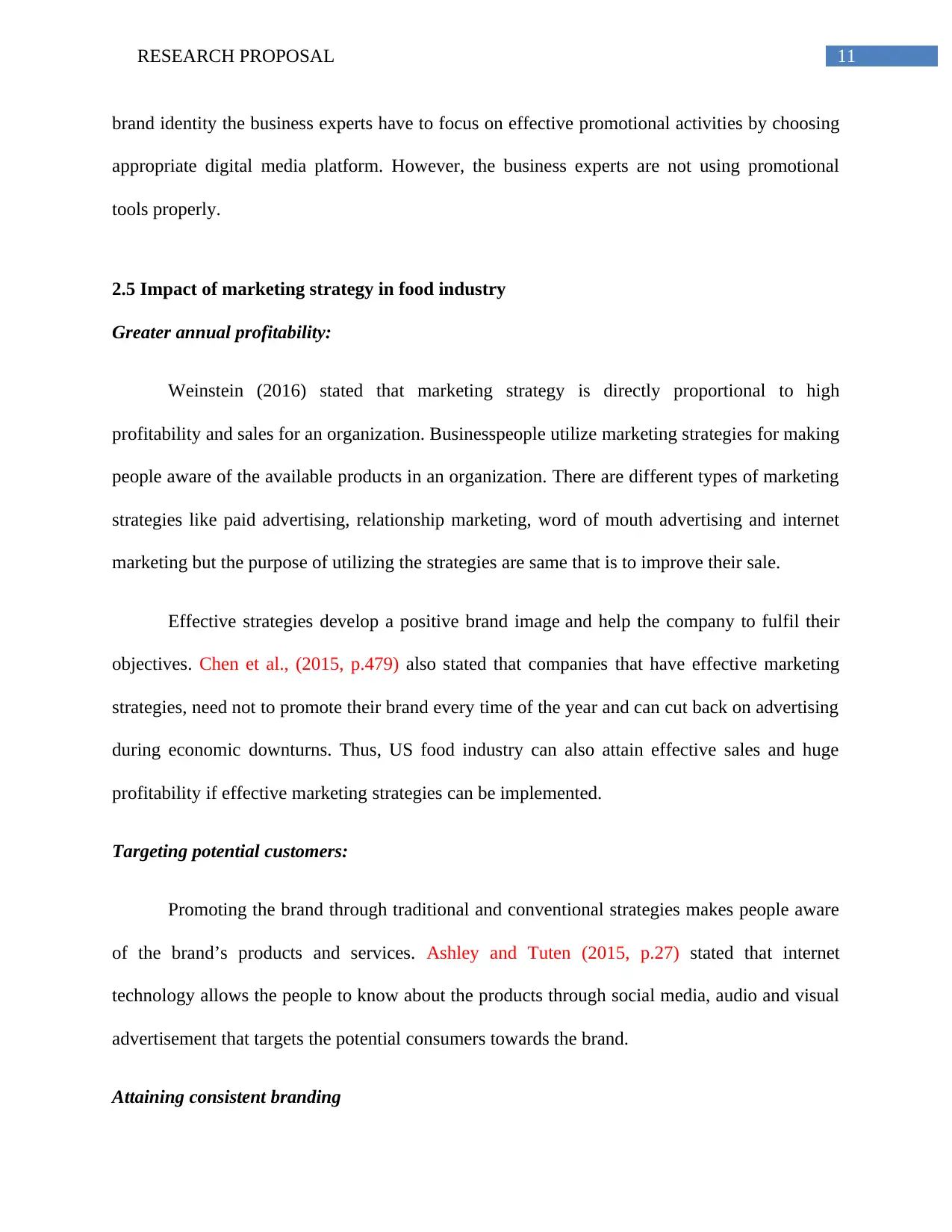
11RESEARCH PROPOSAL
brand identity the business experts have to focus on effective promotional activities by choosing
appropriate digital media platform. However, the business experts are not using promotional
tools properly.
2.5 Impact of marketing strategy in food industry
Greater annual profitability:
Weinstein (2016) stated that marketing strategy is directly proportional to high
profitability and sales for an organization. Businesspeople utilize marketing strategies for making
people aware of the available products in an organization. There are different types of marketing
strategies like paid advertising, relationship marketing, word of mouth advertising and internet
marketing but the purpose of utilizing the strategies are same that is to improve their sale.
Effective strategies develop a positive brand image and help the company to fulfil their
objectives. Chen et al., (2015, p.479) also stated that companies that have effective marketing
strategies, need not to promote their brand every time of the year and can cut back on advertising
during economic downturns. Thus, US food industry can also attain effective sales and huge
profitability if effective marketing strategies can be implemented.
Targeting potential customers:
Promoting the brand through traditional and conventional strategies makes people aware
of the brand’s products and services. Ashley and Tuten (2015, p.27) stated that internet
technology allows the people to know about the products through social media, audio and visual
advertisement that targets the potential consumers towards the brand.
Attaining consistent branding
brand identity the business experts have to focus on effective promotional activities by choosing
appropriate digital media platform. However, the business experts are not using promotional
tools properly.
2.5 Impact of marketing strategy in food industry
Greater annual profitability:
Weinstein (2016) stated that marketing strategy is directly proportional to high
profitability and sales for an organization. Businesspeople utilize marketing strategies for making
people aware of the available products in an organization. There are different types of marketing
strategies like paid advertising, relationship marketing, word of mouth advertising and internet
marketing but the purpose of utilizing the strategies are same that is to improve their sale.
Effective strategies develop a positive brand image and help the company to fulfil their
objectives. Chen et al., (2015, p.479) also stated that companies that have effective marketing
strategies, need not to promote their brand every time of the year and can cut back on advertising
during economic downturns. Thus, US food industry can also attain effective sales and huge
profitability if effective marketing strategies can be implemented.
Targeting potential customers:
Promoting the brand through traditional and conventional strategies makes people aware
of the brand’s products and services. Ashley and Tuten (2015, p.27) stated that internet
technology allows the people to know about the products through social media, audio and visual
advertisement that targets the potential consumers towards the brand.
Attaining consistent branding
⊘ This is a preview!⊘
Do you want full access?
Subscribe today to unlock all pages.

Trusted by 1+ million students worldwide
1 out of 27
Related Documents
Your All-in-One AI-Powered Toolkit for Academic Success.
+13062052269
info@desklib.com
Available 24*7 on WhatsApp / Email
![[object Object]](/_next/static/media/star-bottom.7253800d.svg)
Unlock your academic potential
Copyright © 2020–2025 A2Z Services. All Rights Reserved. Developed and managed by ZUCOL.





